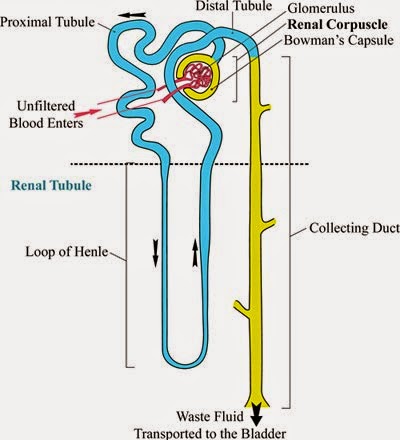 I hate really hate studying this material but once you understand it, it becomes very easy to memorize.
I hate really hate studying this material but once you understand it, it becomes very easy to memorize.
Remember in renal tubular acidosis (RTA) there is normal anion gap. [Na - (Cl - HCO3)] = 6-12.
Proximal part is the upper part of the renal tubules, while the distal part is the end part of the tubules.
Type II (Proximal)
- Pathophysiology: Decreased ability of the proximal kidney tubules to reabsorb most of the filtered bicarbonate because normally bicarbonate is filtered at the proximal tube.
- Urine pH: Variable: Urine pH is basic until bicarbonate is depleted, the it is acidic (less than 5.5)
- Blood K+ level: Low
- Kidney Stones: No
- Associations
- Diagnosis: Infuse bicarbonate and evaluate the urine pH
- Treatment: Thiazide because it causes volume depletion, which will enhance bicarbonate reabsorption.
- Pathophysiology: Distal tubule is damaged so it is unable to generate bicarbonate. Without bicarbonate, H+ cannot be secreted in the tubule to the urine, raising urine pH.
- Urine pH: Urine pH more than 5.5.
- Blood K+ Level: Low
- Kidney Stones: Yes
- Associations
- Amphotericin use
- Lithium Use
- Sickle Cell Disease
- Autoimmune Diseases (SLE, Sjorgen Syndrome, Rheumatoid Arthritis, etc)
- Diagnosis: Infuse acid
- Treatment: Bicarbonate to be absorbed in the proximal tubule, because majority of the bicarbonate is absorbed there.
- Pathophysiology: Decreased or diminished effect of aldosterone at the kidney tubule. Loss of sodium and retention of potassium and hydrogen ions.
- Urine pH: Less than 5.5
- Blood K+ level: High
- Kidney Stones: No
- Associations
- Diabetes
- Addison's Disease
- NSAIDs
- Diagnosis: Urine salt loss, despite sodium restricted diet
- Treatment: Fludrocortisone
0 comments:
Post a Comment